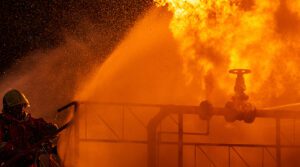
Fire safety engineering
Fire safety engineering in Brazil is moving in stride and such an economically important area for our country cannot be left out of this progress.
In recent years, driven by large fires, there have been significant changes in the legislation of fire protection of the States, we can highlight the fire at Kiss Nightclub in the city of Santa Maria in Rio Grande do Sul in 2013 and the fire at the Alemoa terminal in Santos in 2016, dentrand others, these events led society to reflect and especially the authorities responsible for the supervision of companies and the updating of technical standards that have led to several improvements.
To understand the real fire risks in this category of industry we need to understand the important temperature points that are considered in the risk analysis, we have the flash point that is the temperature that the liquid releases combustible gases that can not sustain the continuity of combustion if the activating energy is, we have in sequence the point of combustion which is the temperature that the liquid releases gases in sufficient quantity for continuity of combustion and finally, we have the ignition point whose amount of gases is sufficient for combustion to happen even without the presence of flames, just contacting gases with a compressive as oxygen.
Click on the image below and read the complete article “Fire safety for lubricating oils” in the digital version of the magazine “LUBES EM FOCO – issue 86” :
We also have an important difference between liquids that release combustible gases that is their classification as flammable or combustible, we have several technical references that present these temperatures, we have the NR 20 – Regulatory Standard of the Ministry of Labor and Social Security, THE ABNT NBR 17.505 – Storage of Flammable Liquids and Fuels, “NFPA 30 – Flammable and Combustible Liquids Code” , we have state fire protection laws, usually called Technical Instructions, among others. Each of these technical standards has its legal good different and are built by professionals with different profiles and histfacts, so do not expect a homogeneity between them, even in the classification of liquids as fuels or flammable we have glaring divergences, it is not a mistake, but rather the divergence of objective of the norms. For fire protection purposes we should use the classification of NBR 17.505, NFA 30 or state Technical Instructions that agree to the  classification of liquids as flammable those with a flash point up to 37.8ºC and combustible liquids those with a flash point above 37.8ºC have no upper limit, i.e. whatever the temperature of the liquid it releases combustible gases will be considered at least as combustible liquid. This classification only determines the “ease” of the liquid in releasing combustible gases, it does not deal with the energy that will be released after the combustion starts, some more modern technical standards such as Data Sheet 07-29 Storage of Ignited Liquids and Portable Containers fm global no longer have the name of combustible or flammable liquids, however still consider their flash points in the fire protection requirements.
classification of liquids as flammable those with a flash point up to 37.8ºC and combustible liquids those with a flash point above 37.8ºC have no upper limit, i.e. whatever the temperature of the liquid it releases combustible gases will be considered at least as combustible liquid. This classification only determines the “ease” of the liquid in releasing combustible gases, it does not deal with the energy that will be released after the combustion starts, some more modern technical standards such as Data Sheet 07-29 Storage of Ignited Liquids and Portable Containers fm global no longer have the name of combustible or flammable liquids, however still consider their flash points in the fire protection requirements.
The lubricant oil industry whether in refining, distribution or final marketing has always had a worried eye for the risk of fire, but there has always been a decrease in concern based on the flash point of oils that are normally above 200ºC, this temperature is not found in any environment, whether industry or in the warehouse, in a normal situation, in the event of fire however, this temperature is quickly reached and the liquids, even with high flash points, will behave like flammable liquids, i.e. everyone will be releasing gases and in contact with the flames will also ignite, in some cases, the liquids can reach the ignition temperature, that is, there is no need for the fire to reach the liquid for it to ignite, it is enough to increase the temperature of the environment so that all liquids in contact with the air ignite.
Now we can understand the need for protective measures for igniferous liquids including those that have high flash points, there are four protection measures that are characteristic of liquids, in addition to traditional ones, such as hydrants, fire extinguishers, emergency signaling, fire alarm, emergency exit and others. Dthese four, duas measures are passive and two active, passive protection measures are arrangement and containment and active protective measures are foam protection and cooling system.
To determine the protection measures first we must frame the real scenario in one of the scenarios provided for in the standards, we can have lubricating oil in its refining phase, in tank storage, in fractional storage, in use in industrial processes, even within these scenarios we can find different risks such as within the category of fractionated liquids, we can have palletized storage, stacked, in pallet door, plastic packaging, metallic, in cardboard boxes, encapsulated, and so on, all the characteristics of liquids, the storage form, the packages influence fire protection and should be considered at the time of the preparation of the fire protection project.





















